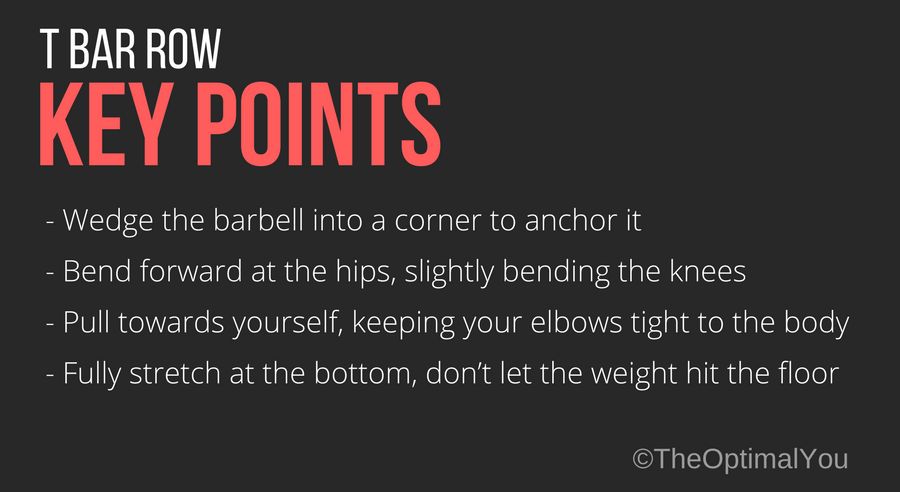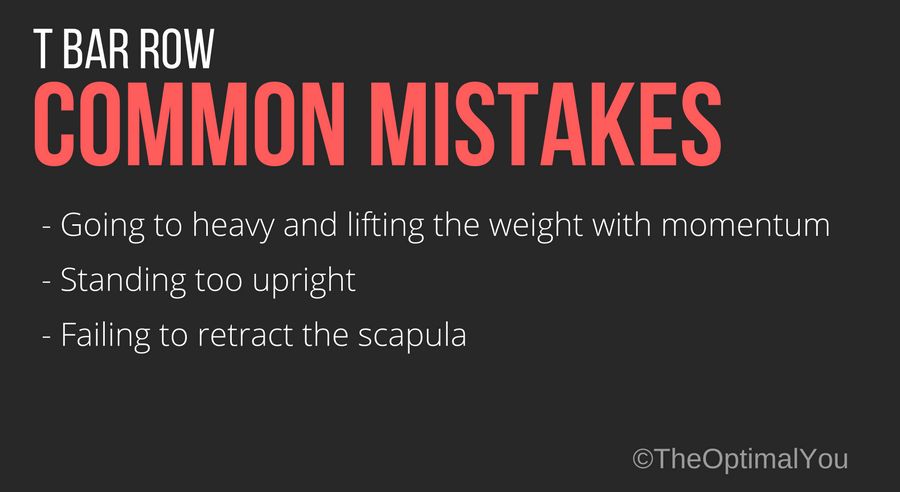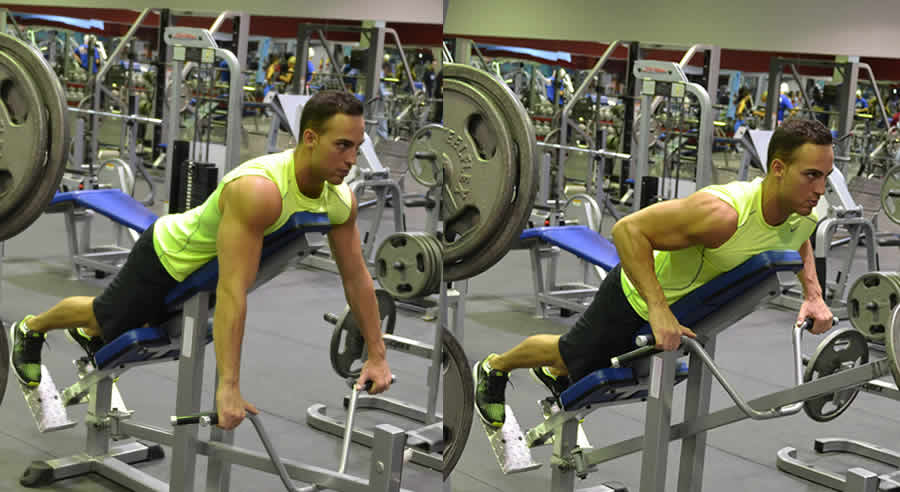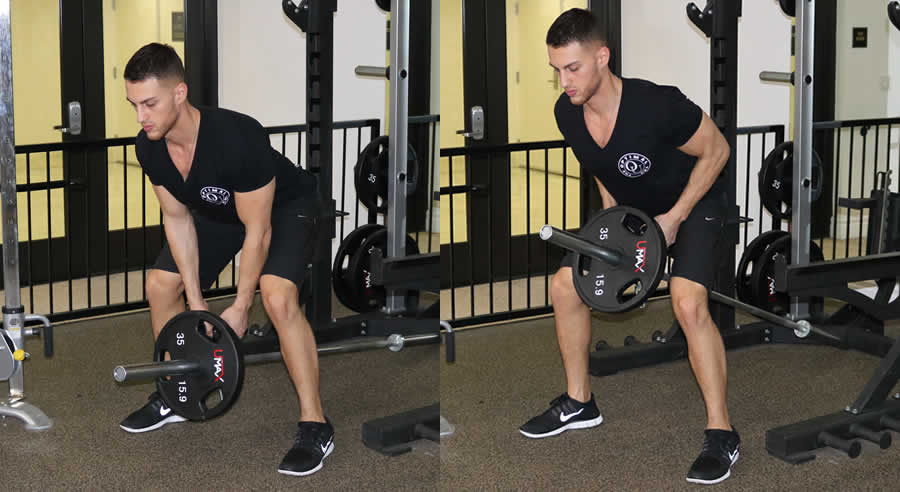Purpose of T-Bar rows
The T-Bar row is one of three primary rowing movements performed with a barbell, the other two being the traditional barbell row, and the underhand barbell row.
The T-Bar row is designed to target many muscles located on the back, but primarily the lats – due to the grip used, and the effect it has on the plane of the movement.
Equipment needed to perform T-Bar rows
Unlike the traditional barbell row, and the underhand barbell row, which require nothing but a barbell, the T-Bar row also requires a corner to wedge one end of the barbell into so that it remains anchored while you perform the exercise, and a triangle cable attachment (the handle you would use when performing a traditional seated cable row, or close-grip pulldown).
Difficulty of T-Bar rows
On a scale of 1 to 5, the T-Bar row would rank around a 3, whereas the traditional barbell row, and underhand barbell row would rank around a 4 – the reason is because with the T-Bar being anchored into a corner, it requires slightly less stability on your part.
How to do T-Bar rows
With one end of the barbell anchored into a corner, stand over the barbell so that it is travelling between both of your feet. Your feet should be in line with the collar of the bar (the larger part of the bar that prevents the weight plates from simply sliding from one end of the bar, to the other).
From this position, bend forward at the hips, slight bend in the knees, while keeping the back straight. Wrap the triangle attachment around the bar below where the weight is, and extend your hips to bring your torso upright just enough so that the weight is no longer resting on the ground – this is the starting position.
From the starting position, pull the barbell as high towards your body as you can, keeping the elbows tight to the body.
Beginners may want to pause at the top to get a feel for the movement, but once you are past the beginner stages this is no longer necessary as it exhausts smaller muscles like the biceps, and forearms, which hinders subsequent performance.
Lower the weight in a controlled manner back down towards the floor, allowing the shoulders blades to protract as much as possible, without letting the weight hit the floor.
Key points when performing T-Bar rows

- Wedge the barbell into a corner to anchor it
- Stand over the barbell, with the bar travelling between both of your feet
- Bend forward at the hips, slightly bending the kneesPull towards yourself, keeping your elbows tight to the body
- Fully stretch at the bottom, but don’t let the weight hit the floor
How many reps when performing T-Bar rows
T-Bar rows can be performed with as low as 6 reps, and as high as 12 reps. The lats are a muscle that needs to be forced into action, and if the weight is too light the biceps and forearms tend to do all of the work. On the flip side, if the weight is too heavy, momentum is generated to propel the weight upwards, which does nothing but reduce muscle activity for the desired areas.
Common mistakes when performing T-Bar rows

Some of the more common mistakes when performing are:
- Going too heavy – as stated above, if the weight is too heavy, momentum is generated to assist with lifting the weight away from the floor, which totally defeats the purpose of doing this exercise in the first place.
- Standing too upright – one of the more common mistakes is people will stand almost completely upright to reduce tension on the lower back. If you instinctively do this to take pressure off your back, you may want to consider an alternative exercise that allows you to more effectively target the same muscles, but with less strain.
- Failing to retract the scapula at the start of each rep – to fully activate the late it is important to start each rep by retracting the scapula back then initiating the pull through your arms.
Modifications to the T-Bar row
The T-Bar row is pretty limited in terms of other ways you can perform it. The only real modifications to make would be if you did not have a triangle cable attachment, you could simply grab onto the bar directly with an off-set grip (one hand above the other, as if holding onto a baseball bat, or golf club), and perform the exercise that way. More advanced gyms may even have an attachment that mimics a barbell, but it’s much rarer.
When to do T-Bar rows
Because smaller, weaker muscles, like the biceps and forearms heavily contribute when performing T-Bar rows, it’s ideal to place them closer to the beginning of a workout.
The more fatigued state you are in when you begin T-Bar rows, the less likely you are to maximally reap the benefits this exercise provides.
Alternatives to T-Bar rows
If your trunk and core can’t handle supporting your bodyweight while also performing T-Bar rows, you could also opt to use a chest-supported T-Bar row machine. Depending on the machine, you may have multiple hand positions available to use, but nearly all of them should have both a close-grip option, and an overhand grip option.
T-Bar rows vs. Overhand Supported Hammer Strength Row
The only real difference between these two variations is that one variation requires you use the muscles of your core and lower back to provide stability, while the other does not.
 Click to view Overhand Supported Hammer Strength Row exercise
Click to view Overhand Supported Hammer Strength Row exercise
If you have access to a chest-supported T-Bar row, you may wish to use it as you are first learning the movement, as it can be used as both a teaching tool, as well as an exercise to stimulate the development of the involved musculature.
It’s also an obvious choice for those who may have back problems but still wish to train the muscles on their back for the purpose of strengthening them.

